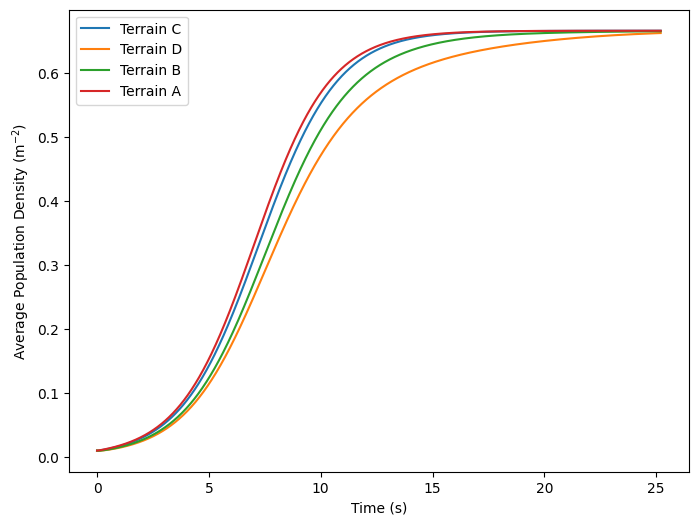Modelling Population Diffusion in a Rough Terrain#
import numpy as np
import matplotlib.pyplot as plt
from matplotlib import animation
from mpl_toolkits.mplot3d import Axes3D
from matplotlib.animation import PillowWriter
from matplotlib import cm
import numba
from numba import jit, vectorize, cuda
from IPython.display import HTML
For a rough terrain, $\( \nabla \cdot (T\,\nabla u) = \nabla \cdot \left(T\frac{\partial u}{\partial x} \hat{x} + T\frac{\partial u}{\partial y} \hat{y} \right)\\ = \frac{\partial}{\partial x}\left(T\frac{\partial u}{\partial x}\right) + \frac{\partial}{\partial y}\left(T\frac{\partial u}{\partial y}\right)\\ = \frac{\partial T}{\partial x}\frac{\partial u}{\partial x} + T\frac{\partial^2 u}{\partial x^2} + \frac{\partial T}{\partial y}\frac{\partial u}{\partial y} + T\frac{\partial^2 u}{\partial y^2}\\ = T\,\nabla^2 u + \frac{\partial T}{\partial x}\frac{\partial u}{\partial x} + \frac{\partial T}{\partial y}\frac{\partial u}{\partial y} \)$
Now consider only the \(x\) coordinate. We can approximate for a fixed \(y\), $\( \frac{\partial T}{\partial x}\frac{\partial u}{\partial x} \approx \frac{T(x-dx)[u(x-dx)-u(x)] + T(x+dx)[u(x+dx)-u(x)]}{2\,dx^2}\\ T\,\nabla^2 u \approx \frac{u(x-dx)-2u(x)+u(x+dx)}{2\,dx^2}T(x) \)$
Hence, the full diverge term becomes for a fixed \(t\)
In a discrete space,
Simulation#
Initialise space grid with random spawns
n = 100
i = 5
coords = np.array([(np.random.randint(i, n-i), np.random.randint(i, n-i)) for _ in range (50)])
init_population = np.zeros((n, n))
for x, y in coords:
init_population[x,y] = 2
fig,ax = plt.subplots()
vmin,vmax = int(np.min(init_population)), int(np.max(init_population))
contourf_ = ax.contourf(init_population, levels=np.linspace(vmin,vmax,400))
cbar = fig.colorbar(contourf_,ticks=range(vmin, vmax))
cbar.ax.set_yticks(ticks=np.linspace(0,2,3))
cbar.ax.set_ylabel('Population Density')
cbar.ax.set_yticklabels(np.linspace(0,2,3), rotation='vertical', va='center')
[Text(1, 0.0, '0.0'), Text(1, 1.0, '1.0'), Text(1, 2.0, '2.0')]
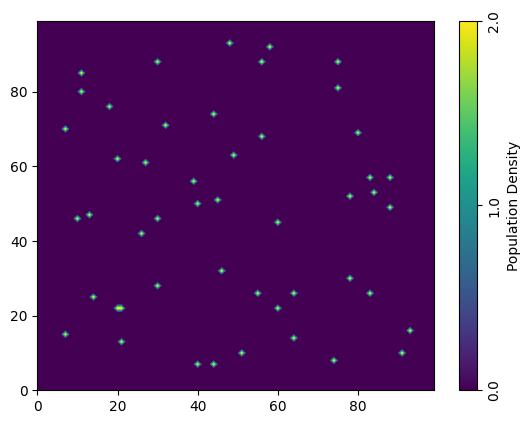
def gauss2d(x, y, cx=0.5, cy=0.5):
# gaussian in domain [0,1] x [0,1]
z = np.exp(-(x-cx)**2-(y-cy)**2)
return z
def gauss2d_inv(x, y, cx=0.5, cy=0.5):
# inverted gaussian function
z = 1-np.exp(-(x-cx)**2-(y-cy)**2)
return z
def twohills(x, y):
# a combination of two gaussian hills
z = 1.04-np.exp((-(x-0.2)**2-(y-0.3)**2)/0.15)-np.exp((-(x-0.8)**2-(y-0.7)**2)/0.1)
return z
def ridge(x,y):
# a terrain function that looks like a ridge
return np.sin((x+3)*(y-0.5)**2)
create rough terrain
X = np.linspace(0, 1, n)
Y = np.linspace(0, 1, n)
X, Y = np.meshgrid(X, Y)
terrain1 = gauss2d(X,Y)
terrain2 = gauss2d_inv(X,Y, cx=0.2, cy=0.4)
terrain3 = twohills(X,Y)
terrain4 = ridge(X,Y)
fig, axes = plt.subplots(ncols=2, nrows=2, figsize=(6,6), sharey=True, sharex=True)
terrains = [terrain1, terrain2, terrain3, terrain4]
for ax, terrain in zip(axes.flat, terrains):
terrain_contour = ax.contour(X,Y,terrain,colors='black')
ax.clabel(terrain_contour, inline=True, fontsize=8)
color = ax.imshow(terrain, extent=[0, 1, 0, 1], origin='lower', cmap='turbo', alpha=0.8, vmin=0)
ax.set_xlabel('x')
ax.set_ylabel('y')
cax = fig.add_axes([0.95, 0.1, 0.04, 0.75])
cbar = fig.colorbar(color, cax=cax, orientation='vertical')
cbar.ax.set_ylabel('Terrain Elevation')
cbar.ax.set_yticklabels(np.linspace(0,0.5,9), rotation='vertical', va='center')
plt.savefig(f'plots/5c/terrains.png', bbox_inches='tight', dpi=200)
C:\Users\beast\AppData\Local\Temp\ipykernel_29256\974144600.py:24: UserWarning: FixedFormatter should only be used together with FixedLocator
cbar.ax.set_yticklabels(np.linspace(0,0.5,9), rotation='vertical', va='center')
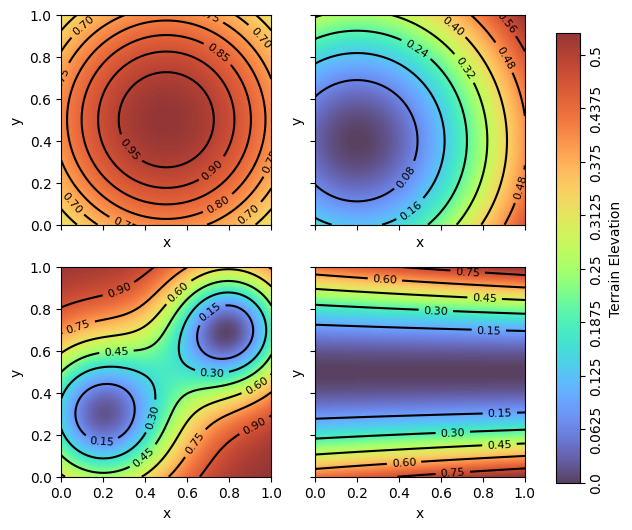
Set the dimensions of the problem
x = 1
dx = 0.05
dt = 0.0001
total_time = 20 # sec
times = 36000*7#int(total_time/dt
times_snapshot = 3600
f = int(times/times_snapshot)
population_frames = np.zeros([times_snapshot, 100, 100])
population_frames[0] = init_population
population_size = np.zeros(times)
Number of differential equation update iterations
timesNumber of snapshots we will take
times_snaphot.The array of snapshots we will take of the turkey
print(f'Snapshot taken every {f}th frame.')
print(f'Total time of simulation is {times*dt} sec.')
print(f'Snapshot taken every {f*dt} sec.')
Snapshot taken every 70th frame.
Total time of simulation is 25.200000000000003 sec.
Snapshot taken every 0.007 sec.
Compute \(s = \alpha \Delta t / \Delta x^2\). \(s\) needs to be much less than 1/4 for this to work.
np.max(terrain4 * dt / dx**2)
0.033658839392315856
Set up numba function
@numba.jit("(f8[:,:,:], f8[:,:], f8, f8, f8)", nopython=True, nogil=True, fastmath = True, parallel=True)
def solve_heat(environment, terrain, K, r, h):
cs = environment[0].copy() #current state
length = len(cs[0])
size = np.zeros(times)
size[0] = np.sum(cs)
cf = 0 # current frame
for t in range(1, times):
ns = cs.copy() # new state
for i in range(1, length-1):
for j in range(1, length-1):
# tr = D[j,i]
growth = dt*((r-h)*cs[j][i] - (r*cs[j][i]**2)/K)
diffusion = (dt/2*dx**2)* (terrain[j,i] *(cs[j, i-1]+cs[j, i+1]+cs[j-1,i]+cs[j+1,i]-4*cs[j,i]) +\
terrain[j-1,i]*(cs[j-1,i]-cs[j,i])+\
terrain[j+1,i]*(cs[j+1,i]-cs[j,i])+\
terrain[j,i-1]*(cs[j,i-1]-cs[j,i])+\
terrain[j,i+1]*(cs[j,i+1]-cs[j,i]))
ns[j][i] = cs[j][i] + growth + diffusion
ns[:,0] = ns[:,1] # left neumann
ns[:,-1] = ns[:,-2] # right neumann
ns[0,:] = ns[1,:] # top neumann
ns[-1,:] = ns[-2,:] # bottom neumann
size[t] = np.sum(cs)
cs = ns.copy()
if t%f==0:
cf = cf + 1
environment[cf] = cs
return environment, size
Simulation for each Terrain#
Terrain 1#
K, r, h = 1, 0.9, 0.3
population_frames, population_sizes = solve_heat(population_frames, terrain1, K, r, h)
plt.plot(np.linspace(0, times*dt, times), population_sizes)
plt.xlabel('Time (s)')
plt.ylabel('Total Population')
vmax = population_sizes[-1]/n**2
print('Final population', population_sizes[-1])
Final population 6666.542632210936
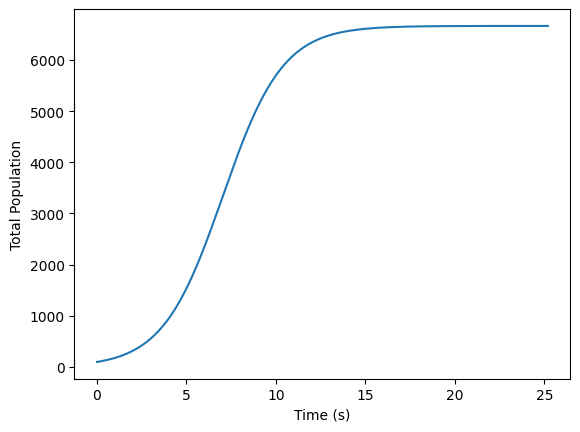
np.save(f'modelled data/hunting/terrain1', population_frames)
Make animation
fig, ax = plt.subplots(figsize=(8,6))
def animate(i):
ax.clear()
a = ax.contourf(population_frames[10*i], 100, levels=np.linspace(0,vmax,50), cmap=plt.get_cmap('inferno'))
ax.set_title(f't = {10*i*f*dt:.2f} sec')
ax.set_xticks([])
ax.set_yticks([])
return fig,
a = ax.contourf(population_frames[10*i], 100, levels=np.linspace(0,vmax,50), cmap=plt.get_cmap('inferno'))
fig.colorbar(a, ax=ax)
ani = animation.FuncAnimation(fig, animate, frames=359, interval=50, blit=True)
# ani.save('animations/5c/terrain1.gif',writer='pillow',fps=30)
HTML(ani.to_html5_video())
Terrain 2#
K, r, h = 1, 0.9, 0.3
population_frames, population_sizes = solve_heat(population_frames, terrain2, K, r, h)
plt.plot(np.linspace(0, times*dt, times), population_sizes)
plt.xlabel('Time (s)')
plt.ylabel('Total Population')
vmax = population_sizes[-1]/n**2
print('Final population', population_sizes[-1])
Final population 6657.8190772686285
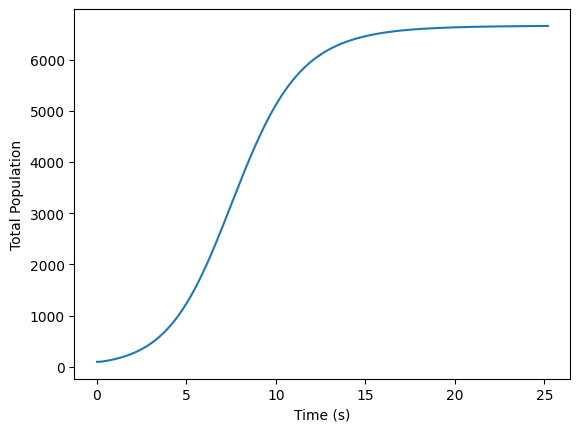
np.save(f'modelled data/hunting/terrain2', population_frames)
Make animation
fig, ax = plt.subplots(figsize=(8,6))
def animate(i):
ax.clear()
a = ax.contourf(population_frames[10*i], 100, levels=np.linspace(0,vmax,50), cmap=plt.get_cmap('inferno'))
ax.set_title(f't = {10*i*f*dt:.2f} sec')
ax.set_xticks([])
ax.set_yticks([])
return fig,
a = ax.contourf(population_frames[10*i], 100, levels=np.linspace(0,vmax,50), cmap=plt.get_cmap('inferno'))
fig.colorbar(a, ax=ax)
ani = animation.FuncAnimation(fig, animate, frames=359, interval=50, blit=True)
ani.save('animations/5c/terrain2.gif',writer='pillow',fps=30)
HTML(ani.to_html5_video())
Terrain 3#
K, r, h = 1, 0.9, 0.3
population_frames, population_sizes = solve_heat(population_frames, terrain3, K, r, h)
plt.plot(np.linspace(0, times*dt, times), population_sizes)
plt.xlabel('Time (s)')
plt.ylabel('Total Population')
vmax = population_sizes[-1]/n**2
print('Final population', population_sizes[-1])
Final population 6666.51034503225
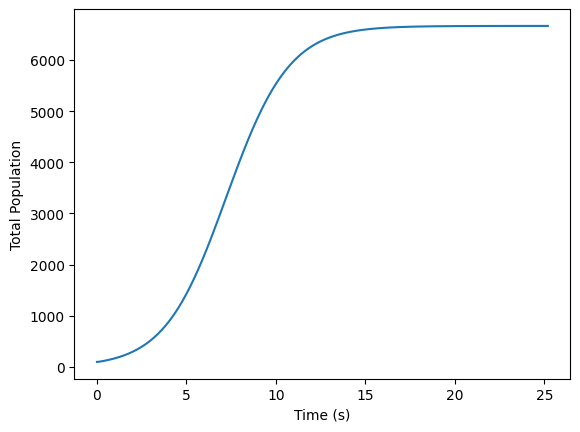
np.save(f'modelled data/hunting/terrain3', population_frames)
Make animation
fig, ax = plt.subplots(figsize=(8,6))
def animate(i):
ax.clear()
a = ax.contourf(population_frames[10*i], 100, levels=np.linspace(0,vmax,50), cmap=plt.get_cmap('inferno'))
ax.set_title(f't = {10*i*f*dt:.2f} sec')
ax.set_xticks([])
ax.set_yticks([])
return fig,
a = ax.contourf(population_frames[10*i], 100, levels=np.linspace(0,vmax,50), cmap=plt.get_cmap('inferno'))
fig.colorbar(a, ax=ax)
ani = animation.FuncAnimation(fig, animate, frames=359, interval=50, blit=True)
ani.save('animations/5c/terrain3.gif',writer='pillow',fps=30)
HTML(ani.to_html5_video())
Terrain 4#
K, r, h = 1, 0.9, 0.3
population_frames, population_sizes = solve_heat(population_frames, terrain4, K, r, h)
plt.plot(np.linspace(0, times*dt, times), population_sizes)
plt.xlabel('Time (s)')
plt.ylabel('Total Population')
vmax = population_sizes[-1]/n**2
print('Final population', population_sizes[-1])
Final population 6630.3617956095695
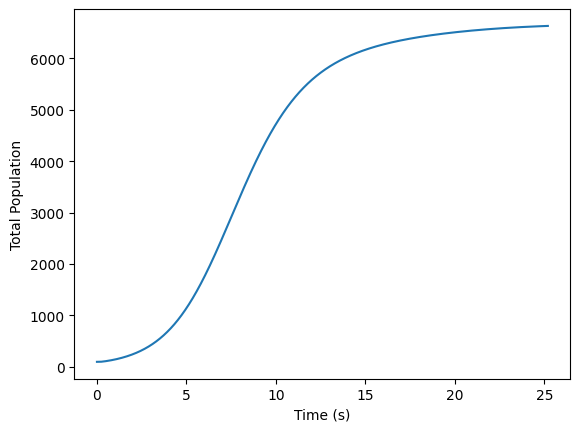
np.save(f'modelled data/hunting/terrain4', population_frames)
Make animation
fig, ax = plt.subplots(figsize=(8,6))
def animate(i):
ax.clear()
a = ax.contourf(population_frames[10*i], 100, levels=np.linspace(0,vmax,50), cmap=plt.get_cmap('inferno'))
ax.set_title(f't = {10*i*f*dt:.2f} sec')
ax.set_xticks([])
ax.set_yticks([])
return fig,
a = ax.contourf(population_frames[10*i], 100, levels=np.linspace(0,vmax,50), cmap=plt.get_cmap('inferno'))
fig.colorbar(a, ax=ax)
ani = animation.FuncAnimation(fig, animate, frames=359, interval=50, blit=True)
ani.save('animations/5c/terrain4.gif',writer='pillow',fps=30)
HTML(ani.to_html5_video())
Population Snapshots#
compare_sizes = {}
my_cmap = plt.get_cmap('inferno')
loc = 'modelled data/hunting'
Terrain 1
name='terrain1'
modelled_frames = np.load(f'{loc}/{name}.npy')
compare_sizes[name] = np.array([np.average(modelled_frames[i]) for i in range(0, 3600, 2)])
show_frame_id = [int(1500/9)*i for i in range(0, 8)]
fig, ax = plt.subplots(figsize=(14,6))
vmax = np.max(modelled_frames[-1])
for i in range(len(show_frame_id)):
plt.subplot(240 + i + 1, anchor='C')
im = plt.imshow(modelled_frames[show_frame_id[i]], cmap=my_cmap, vmin=0, vmax=vmax)
plt.xticks([]), plt.yticks([])
plt.title(f't = {f*dt*show_frame_id[i]:.2f} sec')
im = plt.imshow(modelled_frames[2500], cmap=my_cmap, vmin=0, vmax=vmax)
plt.title(f't = {f*dt*2500:.2f} sec')
fig.subplots_adjust(right=0.8)
cbar_ax = fig.add_axes([0.84, 0.12, 0.05, 0.65])
fig.colorbar(im, cax=cbar_ax)
plt.title('Population\ndensity'+r' (m$^{-2})$'+'\n')
plt.savefig(f'plots/5c/{name}_spread.png', bbox_inches='tight')
plt.show()
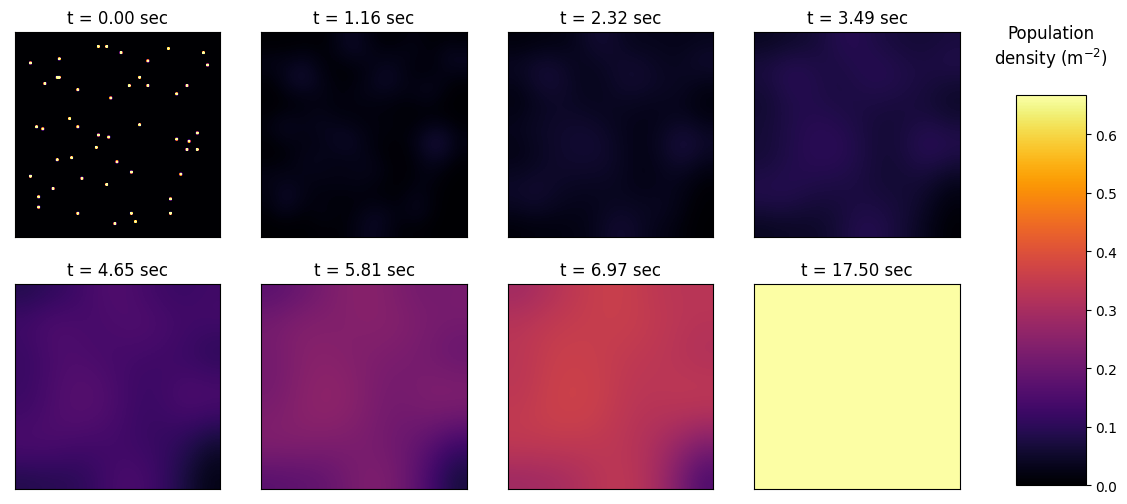
Terrain 2
name='terrain2'
modelled_frames = np.load(f'{loc}/{name}.npy')
compare_sizes[name] = np.array([np.average(modelled_frames[i]) for i in range(0, 3600, 2)])
show_frame_id = [int(1500/7)*i for i in range(0, 8)]
fig, ax = plt.subplots(figsize=(14,6))
vmax = np.max(modelled_frames[-1])
for i in range(len(show_frame_id)):
plt.subplot(240 + i + 1, anchor='C')
im = plt.imshow(modelled_frames[show_frame_id[i]], cmap=my_cmap, vmin=0, vmax=vmax)
plt.xticks([]), plt.yticks([])
plt.title(f't = {f*dt*show_frame_id[i]:.2f} sec')
im = plt.imshow(modelled_frames[2500], cmap=my_cmap, vmin=0, vmax=vmax)
plt.title(f't = {f*dt*2500:.2f} sec')
fig.subplots_adjust(right=0.8)
cbar_ax = fig.add_axes([0.84, 0.12, 0.05, 0.65])
fig.colorbar(im, cax=cbar_ax)
plt.title('Population\ndensity'+r' (m$^{-2})$'+'\n')
plt.savefig(f'plots/5c/{name}_spread.png', bbox_inches='tight')
plt.show()
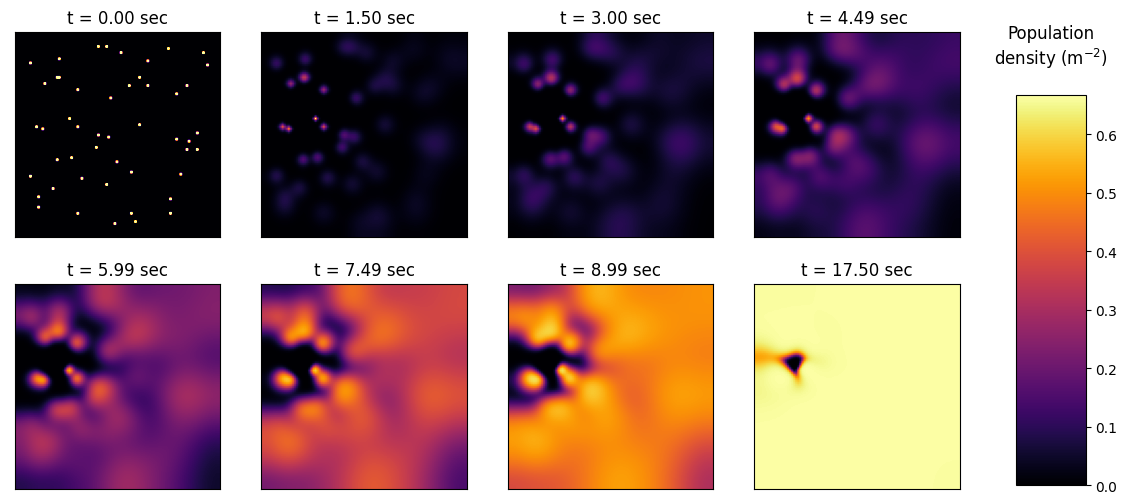
Terrain 3
name='terrain3'
modelled_frames = np.load(f'{loc}/{name}.npy')
compare_sizes[name] = np.array([np.average(modelled_frames[i]) for i in range(0, 3600, 2)])
show_frame_id = [int(1500/6)*i for i in range(0, 8)]
fig, ax = plt.subplots(figsize=(14,6))
vmax = np.max(modelled_frames[-1])
for i in range(len(show_frame_id)):
plt.subplot(240 + i + 1, anchor='C')
im = plt.imshow(modelled_frames[show_frame_id[i]], cmap=my_cmap, vmin=0, vmax=vmax)
plt.xticks([]), plt.yticks([])
plt.title(f't = {f*dt*show_frame_id[i]:.2f} sec')
im = plt.imshow(modelled_frames[2500], cmap=my_cmap, vmin=0, vmax=vmax)
plt.title(f't = {f*dt*2500:.2f} sec')
fig.subplots_adjust(right=0.8)
cbar_ax = fig.add_axes([0.84, 0.12, 0.05, 0.65])
fig.colorbar(im, cax=cbar_ax)
plt.title('Population\ndensity'+r' (m$^{-2})$'+'\n')
plt.savefig(f'plots/5c/{name}_spread.png', bbox_inches='tight')
plt.show()
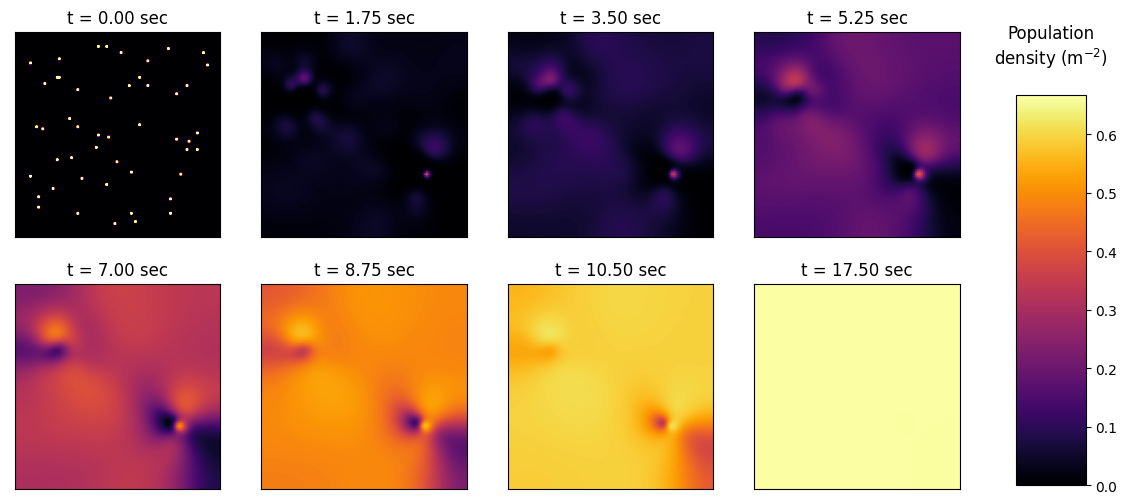
Terrain 4
name='terrain4'
modelled_frames = np.load(f'{loc}/{name}.npy')
compare_sizes[name] = np.array([np.average(modelled_frames[i]) for i in range(0, 3600, 2)])
show_frame_id = [int(1500/9)*i for i in range(0, 8)]
fig, ax = plt.subplots(figsize=(14,6))
vmax = np.max(modelled_frames[-1])
for i in range(len(show_frame_id)):
plt.subplot(240 + i + 1, anchor='C')
im = plt.imshow(modelled_frames[show_frame_id[i]], cmap=my_cmap, vmin=0, vmax=vmax)
plt.xticks([]), plt.yticks([])
plt.title(f't = {f*dt*show_frame_id[i]:.2f} sec')
im = plt.imshow(modelled_frames[2500], cmap=my_cmap, vmin=0, vmax=vmax)
plt.title(f't = {f*dt*2500:.2f} sec')
fig.subplots_adjust(right=0.8)
cbar_ax = fig.add_axes([0.84, 0.12, 0.05, 0.65])
fig.colorbar(im, cax=cbar_ax)
plt.title('Population\ndensity'+r' (m$^{-2})$'+'\n')
plt.savefig(f'plots/5c/{name}_spread.png', bbox_inches='tight', dpi=200)
plt.show()
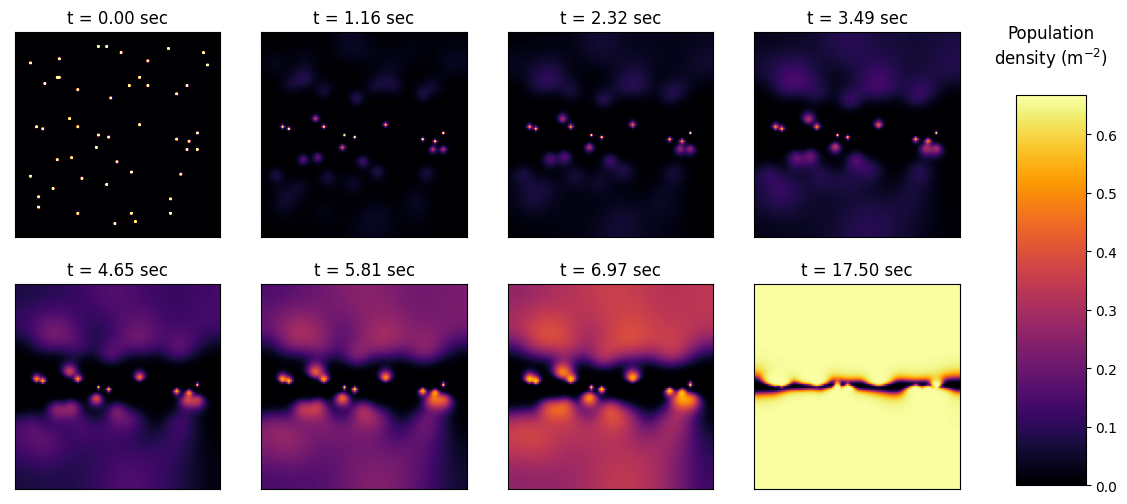
Average Population density over time for each terrain
labels = {
'terrain1': 'Terrain A',
'terrain2': 'Terrain B',
'terrain3': 'Terrain C',
'terrain4': 'Terrain D',
}
plt.figure(figsize=(8,6))
for model in compare_sizes:
plt.plot(np.linspace(0, times*dt, 1800), compare_sizes[model], label=labels[model])
plt.xlabel('Time (s)')
plt.ylabel(r'Average Population Density (m$^{-2}$)')
plt.legend()
plt.savefig(f'plots/5c/all_sizes.png', bbox_inches='tight', dpi=200)
